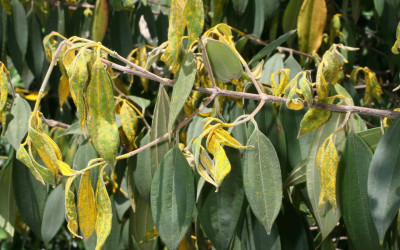MEET THE INVADERS
Myrtle Rust
One of the worst plant diseases Australia has ever faced. Myrtle rust is infecting some of Australia's most iconic trees and shrubs. Our forests are under siege – and time is running out.
Myrtle rust is a silent but deadly killer. Spreading through air and water and hitchhiking on insects and animals, its tiny spores can travel hundreds of kilometres through the wind.
This fungus causes disease in Myrtaceae plants, Australia’s dominant family that includes eucalypts, bottlebrushes and paperbarks⁴. It thrives in warm, moist environments.
Scientifically known as Austropuccinia psidii and previously called ‘eucalyptus rust’ or ‘guava rust’, myrtle rust is native to South America, where it exists without causing much harm to native species due to the resistance of plants that have co-evolved with it.
But it thrives on ‘naive hosts’ – meaning Australia is particularly vulnerable.
It develops as bright yellow powdery spores on young leaves, stems, buds and fruit. Infected plants often develop purple or brown lesions around the spore clusters. Severe infections can result in the complete death of a plant.
While myrtle rust has several strains worldwide, the strain now present in Australia is highly aggressive.

So far myrtle rust has infected over 380 Myrtaceae plant species and many more are susceptible. This makes it one of the most environmentally destructive plant diseases in Australia.
Invasion story
Myrtle rust slipped into Australia unnoticed – likely months before it was officially detected on 23 April 2010 at a New South Wales nursery.
With lax surveillance at the time, the disease took hold, spreading through infected nursery stock.
At first, only 2 private properties were affected but within 9 months it had spread into bushland. From then, myrtle rust spread like wildfire.
Reaching Queensland in December 2010, and Victoria in 2011, it swept across eastern and northern Australia.
It infiltrated protected areas too – like the Wet Tropics World Heritage Area in Queensland, World Heritage K’gari (Fraser Island) and Lord Howe Island and Royal National Park in New South Wales.
Today, South Australia remains the only state without it.
How did we get here?
Before myrtle rust arrived, it was causing havoc overseas. In 2005, Hawaii was hit hard, with the rust wiping out vast swathes of rose apple (an introduced tree) as well as an endangered native shrub, the nioi.
Australia’s plant pathology community became very concerned as they watched its spread overseas for over a decade.
In 2006, the Primary Industries Ministerial Council (consisting of all Australia’s agricultural ministers) categorised it as ‘one of the most serious threats to Australian production forests and natural ecosystems.
Seeds, nursery stock, bark crevices, lumber and wood packaging material, including dunnage with attached bark, were identified as potential pathways for the importation of spores.
The federal government released a national response plan in 2007. The Invasive Species Council urged the government to put a strategic plan into action urgently in 2008.
Plant Health Australia published a contingency plan for the nursery and garden industry in 2009, identifying the rust as a ‘high-extreme’ risk for the nursery industry. Oddly and unjustifiably, the plan gave a lower risk rating for the environment.
Whilst the disease had been recognised as high risk for several years and response plans developed, no surveillance program was in place and Australia was poorly prepared.
A national action plan for plant conservation wasn’t published until July 2020 – a full decade after myrtle rust’s arrival.
Eradicating new diseases in native species is rarely possible. Once they take hold, responsibility falls to states and territories – often leading to patchy, underfunded responses. The Invasive Species Council has been advocating for a cohesive national focus on catastrophic emerging disease threats, including under the national environmental law (the EPBC Act).
The toll on nature
Myrtle rust is now one of the worst plant threats Australia has faced and it’s leaving a trail of destruction in its wake.
This fast-spreading fungus could quietly reshape our forests, heathlands and wetlands, with Australia particularly susceptible due to its lack of previous exposure to this rust.
This fungus causes disease in family Myrtaceae plants – like iconic bottlebrushes and paperbarks.
Family Myrtaceae makes up 10% of Australia’s entire native plants – there is a lot at stake.
The disease impacts plants by attacking new growth of leaves, buds and fruits. While some species can shake it off with minor leaf spotting, others are hit much harder. Species with small, fragmented populations can be pushed to extinciton.
Alarmingly, a 2020 survey pinpointed 16 Myrtaceae species at imminent risk of extinction (within one generation), including the grey teak (Backhousia hughesii) and Mount Lewis myrtle (Gossia lewisensis).
Native guava (Rhodomyrtus psidioides), once common along a 900-kilometre stretch of Australia’s east coast, became critically endangered in a decade, with more than 80% of infected trees dying and myrtle rust preventing regeneration. The brush turpentine (Rhodamnia rubescens), another casualty, has seen dramatic declines.
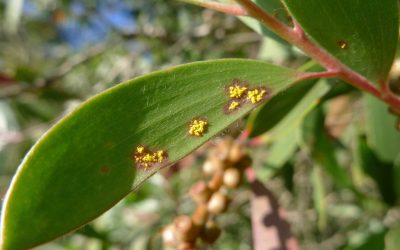
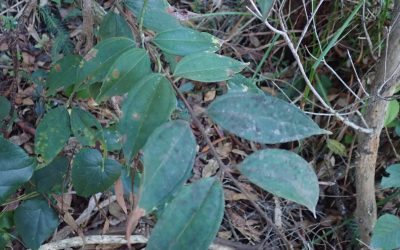
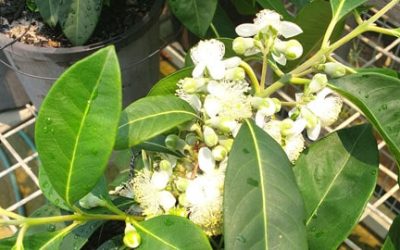
Cultural consequences
The impact of this extends beyond individual species. Rainforests, wetlands and even riverbanks are feeling the strain. So are the wildlife who depend on them.
In Queensland and New South Wales, the death of native guava trees along rainforest edges has created an opening for invasive weeds like lantana (Lantana camara). This opportunistic plant chokes the regrowth of native plants, disrupts food, water and shelter resources for native animals and fuels bushfires.
Many of the species under threat by myrtle rust are also used for traditional Indigenous practices.
For example, paperbark trees are traditionally used for wrapping food to cook, lining ground ovens and constructing shelters. Their flowers also provide nectar for food and medicine. A decline in these species reduces the ability for living cultural practices.
The situation could worsen if eucalypt-killing strains of myrtle rust were to make their way to Australia. Eucalypt forests are the lifeblood of much of Australia’s environment, providing habitat for iconic species like koalas, greater gliders and swift parrots. The knock-on effects of losing these trees would mean that Australia would never be the same.

Myrtle rust affects our economy as well! Nurseries must now use costly fungicides and abandon some susceptible plant species, while the lemon myrtle industry struggles with increased costs, limiting organic production. If myrtle rust spreads, it could devastate Geraldton wax farms.
How do we fix this?
Some of Australia’s unique native plants – found nowhere else on earth – are at imminent risk from myrtle rust.
If new overseas strains arrive, it could be game over for some of our precious Myrtaceae plant species and would impact the native animals that rely on them for survival too.
But there could be some hope on the horizon. Scientists at The University of Queensland have developed a revolutionary RNA spray that can prevent infections and even cure severely infected trees within weeks. Fungicides are also being used, but they’re expensive and require constant application.
For the species at greatest risk, seed banking (collection and safe storage of seeds) will ensure survival even if they go extinct in the wild.
But without greater investment in research and prevention, myrtle rust will continue its march through our precious environment.
The Invasive Species Council is urgently calling for more action and investment to prevent other strains from arriving and to fully implement the Myrtle Rust National Action Plan.
This includes saving species at risk of extinction, research to better understand the disease and the potential for resistance and stronger prevention at the border to stop new strains from arriving.
We can’t afford to repeat the mistakes of the past.
We all must do everything we can to prevent more irreversible damage to safeguard the intricate web of life that makes Australia the place we know and love.

Take action: Tell the government you want to see better laws and policies to deal with threats to nature like myrtle rust.
Take precautions: Clean equipment, boots, clothing and vehicles after visiting bushland or areas where myrtle rust may be present to prevent spreading spores to new locations.
Report it: Familiarise yourself and friends with the signs of myrtle rust, such as bright yellow spores on leaves, stems, and flowers, and report any sightings to your local biosecurity authority.
FAQs
How exactly myrtle rust entered Australia is not known. In 2006, seeds, nursery stock, bark crevices, lumber and wood packaging material, including dunnage with attached bark, were identified as potential pathways for the importation of spores.
Preventing further spread of myrtle rust requires enhanced biosecurity measures, more research, and nationally coordinated response plans. It is crucial to stop new strains from entering Australia and to focus on prevention, detection, and eradication strategies.
Public awareness and advocacy are essential. Support research, biosecurity efforts, and policies that focus on preventing the spread of myrtle rust. It’s also important to be mindful of not transporting potentially infected plants or materials.
Despite warnings from scientists, industry and environmentalists (including the Invasive Species Council), the threat of myrtle rust, while acknowledged, was not given the urgency and resources needed to adequately prepare for it. Had there been more resources and commitment for the initial response, we might have avoided such a devastating environmental fallout.
Glen M, Alfenas AC, Zauza EAV, Wingfield MJ, Mohammed C. (2007) Puccinia psidii: a threat to the Australian environment and economy. Australasian Plant Pathology 36: 1–16.
Ramsfield TD, Dick MA, Beever RE, Cannon PG. (2010) Austropuccinia psidii, a threat to New Zealand’s indigenous forests? New Zealand Journal of Forestry Science 40: 77–94.
Carnegie AJ, Pegg GS. (2018) Lessons from the incursion of myrtle rust in Australia. Annual Review of Phytopathology 56: 457–478.
Makinson RO, Pegg GS, Carnegie AJ. (2020) Myrtle Rust in Australia – a National Action Plan. Australian Plant Biosecurity Science Foundation, Canberra, Australia.
Uchida J, Zhong S, Killgore E. (2006) First report of a rust disease on ohiʻa caused by Puccinia psidii in Hawaii. Plant Disease 90: 524.
Primary Industries Ministerial Council. (2006) National Priority Plant Pests. Canberra, Australia.
Office of the Chief Plant Protection Officer. (2007) Myrtle Rust National Response Plan. Canberra, Australia.
Plant Health Australia. (2009) Myrtle Rust Contingency Plan – Nursery and Garden Industry. Canberra, Australia.
Carnegie AJ, Cooper K. (2011) Emergency response to the incursion of an exotic myrtaceous rust in Australia. Australasian Plant Pathology 40: 346–359.
National Management Group. (2010) Final Decision on Myrtle Rust Eradication Feasibility. Canberra, Australia.
Consultative Committee on Emergency Plant Pests. (2010) Minutes of Meeting on Myrtle Rust Response. Canberra, Australia. (Obtained under FOI)
Low, T., & Booth, C. (2023). GONE: Australian animals extinct since the 1960s. Invasive Species Council Inc. Retrieved from https://invasives.org.au/wp-content/uploads/2024/11/Gone-Report-Updated-2024.pdf
Australian Government Department of Agriculture, Water and the Environment. 2020. Conservation Advice for Rhodomyrtus psidioides (Native Guava). Available at: https://www.environment.gov.au/biodiversity/threatened/species/pubs/19162-conservation-advice-12122020.pdf
Fensham, R, Collingwood T, Radford-Smith, J. 2021. Unprecedented extinction of tree species by fungal disease. Biological Conservation. 261: 109276
Carnegie AJ, Kathuria A, Pegg GS, Entwistle P, Nagel M, Giblin FR. 2016 Impact of the invasive rust Puccinia psidii (myrtle rust) on native Myrtaceae in natural ecosystems in Australia. Biological Invasions 18: 127–144. DOI 10.1007/s10530-015-0996-y
Fensham, RJ, Carnegie, AJ, Laffineur, B, Makinson, RO, Pegg, GS, Wills, J. 2020. Imminent Extinction of Australian Myrtaceae by Fungal Disease. Trends in Ecology & Evolution, 35 (7): 554-557
Department of Agriculture, Water and the Environment. 2020. Conservation advice for Rhodomyrtus psidioides (native guava). Canberra: Australian Government. Available from: https://www.environment.gov.au/biodiversity/threatened/species/pubs/19162-conservation-advice-12122020.pdf
Makinson RO, 2018. Myrtle Rust reviewed: the impacts of the invasive pathogen Austropuccinia psidii on the Australian environment. Plant Biosecurity Cooperative Research Centre, Canberra.
Degnan, R., Sawyer, A., & Mitter, N., “High-tech spray prevents and cures rusty plant threat,” UQ News, 14 February 2024, https://www.uq.edu.au/news/article/2024/02/high-tech-spray-prevents-and-cures-rusty-plant-threat.
Berthon K, Esperon-Rodrigueza M, Beaumont LJ, Carnegie AJ, Leishman MR. 2018. Assessment and
prioritisation of plant species at risk from myrtle rust (Austropuccinia psidii) under current and future
climates in Australia. Biological Conservation 218: 154–162. https://doi.org/10.1016/j.biocon.2017.11.035
Carnegie, AJ. and Pegg, GS. 2018. Lessons from the incursion of myrtle rust in Australia. Annual Review of Phytopathology, 56 . pp. 457-478.
Booth C. 2011. Overseas incubators. Feral Herald 27. Invasive Species Council.
Carnegie A, Lidbetter J, Walker J, Horwood M, Tesoriero L, Glen M, Priest M. 2010. Uredo rangelii, a taxon in the guava rust complex, newly recorded on Myrtaceae in Australia. Australasian Plant Pathology 39: 463-466
Carnegie A, Cooper K. 2011. Emergency response to the incursion of an exotic myrtaceous rust in Australia. Australasian Plant Pathology 40(4): 346-359.
Carnegie A, Lidbetter J. 2012. Rapidly expanding host range for Puccinia psidii sensu lato in Australia. Australasian Plant Pathology, 41(1): 13-29.
Consultative Committee on Emergency Plant Pests. 2010. For NMG Meeting No 3. , 2 July 2010. (Obtained under FOI)
Coutinho T, Wingfield M, Alfenas A, Crous P. 1998. Eucalyptus Rust: A Disease with the Potential for Serious International Implications. Plant Disease 82:819-825.
Deighton L, Higgins E. 2011. Myrtle rust ‘biggest threat to ecosystem’. The Australian 9 April 2011. (http://www.theaustralian.om.au/news/health-science/myrtle-rust-biggest-threat-to-ecosystem/story-e6frg8y6-1226036247221)
Fensham, R, Collingwood T, Radford-Smith, J. 2021. Unprecedented extinction of tree species by fungal disease. Biological Conservation. 266
Fensham, RJ, Carnegie, AJ, Laffineur, B, Makinson, RO, Pegg, GS, Wills, J. 2020. Imminent Extinction of Australian Myrtaceae by Fungal Disease. Trends in Ecology & Evolution, 35 (7): 554-5571: 10927
Hardstaff, LK, Sommerville, KD, Funnekotter, B, Bunn, E, Offord, CA, Mancera, RL. 2018. Myrtaceae in Australia: Use of Cryobiotechnologies for the Conservation of a Significant Plant Family under Threat. Plants 2022 (11) 1017. https://doi.org/10.3390/plants11081017
Giblin F. 2013. Myrtle Rust report: New Caledonia. Assessment of Myrtle Rust situation in New Caledonia, 13 May 2013 – 17 May 2013. University of the Sunshine Coast.
Glen M, Alfenas AC, Zauza EAV, Wingfield MJ, Mohammed C (2007) Puccinia psidii: a threat to the Australian environment and economy – a review. Australasian Plant Pathology 36: 1-16
Grgurinovic CA, Walsh D, Macbeth F. 2006. Eucalyptus rust caused by Puccinia psidii and the threat it poses to Australia. EPPO Bulletin 36: 486–489
International Plant Protection Convention. 2013. Changes to import conditions for Myrtaceous timber.12 June 2013. (https://www. ippc.int/news/changes-import-conditions- myrtaceous-timber).
Kawanishi T, Uematsu S, Kakishima M, Kagiwada S, Mamamoto H, Morie H, Namba
2009. First report of rust disease on ohia and the causal fungus, Puccinia psidii, in Japan, Journal of General Plant Pathology 75: 428-31.
Loope L. 2010. A summary of information on the rust Puccinia psidii Winter (guava rust) with emphasis on means to prevent introduction of additional strains to Hawaii. US Geological Survey Open-file Report 2010-1082.
Makinson R. 2014. Exotic Rusts on Myrtaceae. Key threatening process nomination under the EPBC Act.
Makinson RO, 2018. Myrtle Rust reviewed: the impacts of the invasive pathogen Austropuccinia psidii on the Australian environment. Plant Biosecurity Cooperative Research Centre, Canberra.
Makinson RO, Pegg GS, Carnegie AJ. 2020. Myrtle Rust in Australia – a National Action Plan, Australian Plant Biosecurity Science Foundation, Canberra, Australia.
Minister for Agriculture, Fisheries and Forestry. 2013. Senate Question No 2670. 14 January
2013.
Morin L, Aveyard R, Lidbetter J (2011) Myrtle Rust: host testing under controlled conditions. Report no C2010/9785, July 2011. CSIRO & NSW Dept of Primary Industries.
Morin L, Aveyard R, Lidbetter J, Wilson P. 2012. Investigating the host-range of the rust fungus Puccinia psidii sensu lato across tribes of the family Myrtaceae present in Australia. PLoS ONE 7(4).
National Management Group. 2010a. Interim Response Plan Myrtle Rust Incursion. 2 July 2010. (Obtained under FOI)
National Management Group. 2010b. Myrtle rust in NSW – status review. (Obtained under FOI.)
National Management Group. 2010c. National Management Group Out of Session Paper No. 1, 13 May 2010. (Obtained under FOI)
NSW Department of Primary Industries. 2012. Field hosts of Myrtle rust recorded in NSW. Current at 25 May 2012. (http://www.dpi.nsw. gov.au/biosecurity/plant/myrtle-rust/hosts)
NSW Scientific Committee. 2011. Key Threatening Process – Final Determination: ‘Introduction and establishment of Exotic Rust Fungi of the order Pucciniales pathogenic on plants of the family Myrtaceae.
Office of the Chief Plant Protection Officer. 2007. Puccinia psidii. Forestry, rural and urban biosecurity plan. Pest specific contingency plan. Australian Government Department of Agriculture, Fisheries and Forestry, Canberra.
Pegg G, Giblin F, McTaggart A, Guymer G, Taylor H, Ireland K, Shivas R, Perry S. 2013. Puccinia psidii in Queensland, Australia: disease symptoms, distribution and impact. Plant Pathology Doi: 10.1111/ppa.12173
Pegg G, Perry S, Carnegie A, Giblin F. 2014. Managing myrtle rust- a menace to our Myrtaceae. Presentation. Plant Biosecurity CRC.
Pegg G, Taylor T, Entwistle P, Guymer G, Giblin F, Carnegie A (2017) Impact of Austropuccinia psidii
(myrtle rust) on Myrtaceae-rich wet sclerophyll forests in south east Queensland. PLoS ONE 12(11):
e0188058.
Plant Health Australia (2009) Threat Specific Contingency Plan – Guava (eucalyptus) rust Puccinia psidii. Industry biosecurity plan for the nursery and garden industry. Plant Health Australia, Deakin ACT.
Primary Industries Ministerial Council. 2006. Records and Resolutions of the Primary Industries Ministerial Council, 20 April 2006.
Queensland government. 2014. Known plants affected by myrtle rust. (http://www. business.qld.gov.au/industry/agriculture/land- management/health-pests-weeds-diseases/ weeds-and-diseases/identify-myrtle-rust/ plants-affected-myrtle-rust)
Tommerup I, Alfenas A, Old K. 2003. Guava rust in Brazil – a threat to Eucalyptus and other Myrtaceae. New Zealand Journal of Forestry Science 33(3): 420-428
Uchida J, Zhong S, Killgore E. 2006. First report of a rust disease on Ohia caused by Puccinia psidii in Hawaii. Plant Disease 90: 524
Wingfield M, Roux J, Wingfield B. 2011. Insect pests and pathogens of Australian acacias grown as non-natives – an experiment in biogeography with far-reaching consequences. Diversity and Distributions 17: 968–977
Banner image credits: Sarah Smith, Stephen Thorpe & Chris Ecroyd
Related content
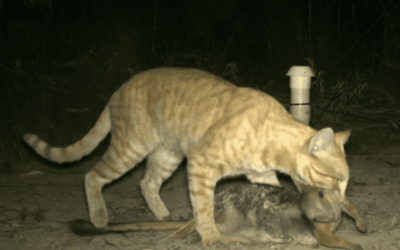
Learn about more of Australia’s worst invasive species.






